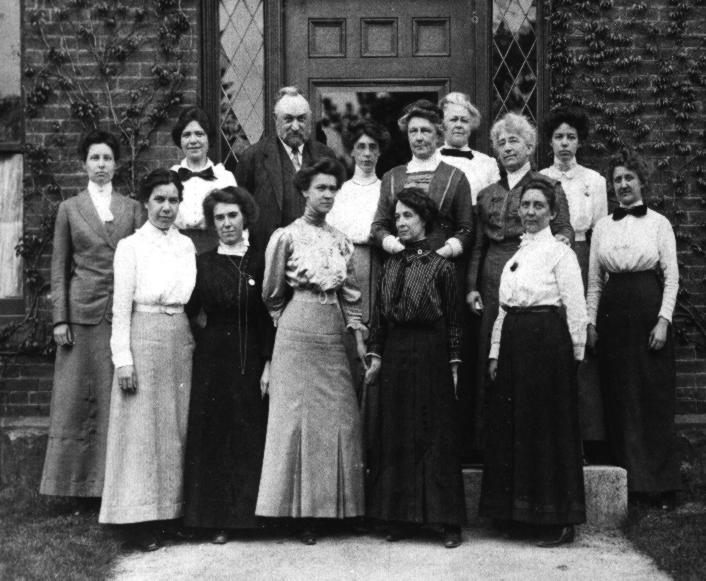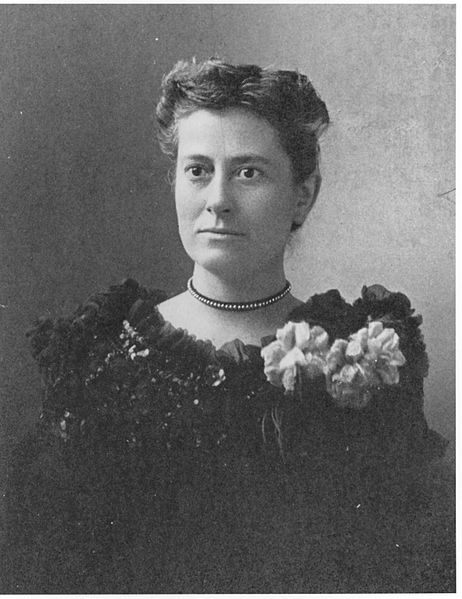How Female Computers Mapped the Universe and Brought America to the Moon
Teams of female scientists made critical breakthroughs in astronomy and mathematics–but it was decades before they’d get credit for them.

The group of women computers at the Harvard College Observatory, who worked for the astronomer Edward Charles Pickering, c. 1890. (Photo: Harvard College Observatory/Public Domain)
At Harvard Observatory in the late 1800s, over a dozen computers hummed from the busy astronomy calculation room. Devising complex calculations to map the stars, the computers worked in skirts and corsets, gripping their pencils at thick wooden desks. If you haven’t guessed, these computers were not the sort we think of today, but were teams of people using arithmetic to transform raw observational data into a useable form.
Harvard’s female computers, sitting in a small room with floral wallpaper, surrounded by stacks of papers and star charts, not only advanced the field of astronomy, but created new systems to study the stars that are still used today—though the women themselves largely worked behind the scenes, a trend that continued throughout the 19th century and into the space age.
Unfortunately, the women at Harvard (these days called the “Harvard Computers”), were not exactly recognized for their individual contributions to mathematics and astronomy. At the time, they were known colloquially as “Pickering’s Harem,” and it was believed that the computing work they were doing was akin to the tedium of embroidery.

A photo from 1913 showing the female Harvard computers with Edward Charles Pickering. (Photo: Harvard-Smithsonian Center for Astrophysics/Public Domain)
If calling these female professionals a “harem” sets off a red flag for misogyny, you’d be onto something; their hire was characterized by the ironic mix of sexism and opportunity that defined late 19th-century progressivism. While men were also employed as computers for various mathematical tasks, clerical work (barred to women before the Civil War) had begun to be viewed as “women’s work”–even when it involved intricate calculations, cataloguing, and data analysis. Many of the male scientists of the era would never have guessed that the “busywork” they handed to female computers in the late 1800s would go on to become so important.
In the 19th century, Harvard Observatory was one of the most prominent astronomical studies centers of the United States, but the institution had a bit of a data problem: there was too much of it to handle. David Alan Grier writes in When Computers Were Human that a “decade of numbers” was left behind by a former astronomer, Joseph Winlock, who apparently loved recording the information without putting it into any usable or practical form.
With the data for thousands of observations recorded by men with telescopes, the observatory had to act. Edward Pickering, the director of the observatory, employed a male assistant, but disliked his work ethic and cataloguing skills. In 1881, he decided to turn to someone close to him who he thought would produce more thorough clerical work: his housemaid, Williamina Fleming.

Wilhelmina Fleming circa 1890s. (Photo: Courtesy Curator of Astronomical Photographs at Harvard College Observatory/Public Domain)
Pickering, who was seen as a liberal progressive, thought hiring Fleming as a “computer,” to catalogue the data and do all the tedious work the men couldn’t be bothered to do, seemed like a good bet. Hired at a mere 25 to 50 cents an hour, not only were women like Fleming getting the job done, but they were saving the observatory a fair bit of money.
Grier writes the women’s rate was half that normally paid for calculation work—cheap labor that made other observatories jealous as Pickering wrote that “a skillful observer should never be obliged to spend time on what could be done equally well by an assistant at a much lower salary.”
As archaic as that sounds now, at the time Harvard Observatory was one of the only options in the area for a female mathematician to apply her skills. Women’s colleges existed, but assumed graduates would get married rather than start a career; female graduates were eager to use their mathematical knowledge for real-world use.
Fleming, whose prior gig as a housemaid paid less than the academic work, jumped at the chance—and luckily so for future astronomers; the Harvard Observatory would go on to become an incubator for the skills of brilliant women. Over her 36-year career at the Harvard Observatory, Fleming not only discovered and catalogued over 10,000 stars, several nebulae, and the existence of white dwarf stars, she also oversaw more than 80 other female computers, many of whom came straight from college or high school.

Harvard College Observatory, c. 1900. (Photo: Library of Congress/LC-DIG-det-4a08545)
One of her employees, Henrietta Swan Leavitt, discovered a logarithmic relationship between the luminosity period of certain stars that change in apparent brightness over time and their distance from others, a method that let astronomers measure our proximity to other galaxies. Another, Annie Jump Cannon, a mathematics and astronomy graduate of Wellesley College in Massachusetts, brought new knowledge of interactions of light, matter and radiation through her interest in spectroscopic astronomy.
Over the course of four years Cannon and her colleagues methodically studied thousands of photographic plates of the night sky for the Henry Draper Catalogue, a massive data collection project published from 1918 to 1924, that aimed to map every star that could be photographed at the time (and contributed to her staggering classification of over 500,000 stars).
By the time the catalogue was published, Cannon had invented the Harvard classification system, which orders star types based on their brightness and size. We still use it today: astronomy students memorize the letters O, B, A, F, G, K, M (known by the mnemonic “Oh Be a Fine Girl, Kiss Me“).
Stars were, for the first time, catalogued by one of their most telling qualities: temperature, which can help indicate size and age. Not only did this system distinguish one star from the next, it helped lay out the possibilities those stars told of its surrounding universe: how far it was from earth, the possible characteristics of planets orbiting around its mass, when it might explode.

Annie Jump Cannon and Henrietta Swan Leavitt, 1913. (Photo: Harvard University Library/Public Domain)
This trend for women to do the computational work of astronomy continued into the 20th century. In 1935, five women joined the predecessor of NASA, National Advisory Committee for Aeronautics (NACA) as computers, and, NASA reports, became “essential to operations at the center“, and more efficient than the male engineers. After the shortage of male workers following World War II, the Langley Research Center in Virginia of NACA employed hundreds of female computers who, like their Harvard predecessors, advanced astronomical knowledge.
In the segregated west end of the facility of NACA, a new research team of black women emerged, known as the West Area Computers, who ultimately drove the success of the early flight and space research program. When NACA became NASA in 1958, and the space program took priority, they again needed extra help, and yes, that meant looking toward female computers to provide the complex calculations required for space flight.
Once again the door for women in the sciences opened as Katherine Johnson, a mathematical child prodigy who graduated from college at age 18, responded to that call. Born the same year Harvard Observatory Computers were scratching pencils and studying photographs of the night sky in 1918, she joined their historic ranks as one of the most important mathematicians in the astronomy field in the U.S. Wini Warren writes in Black Women Scientists in the United States that Johnson was “loaned out to the Flight Research Division and never sent back” for her recognized genius.
She calculated the trajectory of the first American in space, and her calculations even guided the spacecraft of Neil Armstrong and Buzz Aldrin safely through the first moon mission of Apollo 11. According to NASA, even when the electronic computers we use today became popular, John Glenn “requested that she personally recheck the calculations made by the new electronic computers before his flight aboard Friendship 7—the mission on which he became the first American to orbit the Earth.”

Katherine Johnson sits at her desk with a globe, or “Celestial Training Device”, at NASA. (Photo: NASA/Public Domain)
Women like Johnson are now getting some much-warranted credit for their work; Margot Shetterly will explore the histories of the black women of the West Area Computer team in her book Hidden Figures: The Story of the African-American Women Who Helped Win the Space Race, set to come out this year. While most of the female Harvard Computers didn’t get the recognition they deserved during their lifetimes, they certainly helped forge the way for women in science.
Today, statistics show that the sciences are still held away from women, with female scientists explaining that the same prejudices that kept women from the engineer’s room in the 1800s and 1940s keep them from these occupations today. But fortunately that isn’t keeping women from breaking through the glass ceiling of the observatory room; programs and mentors for women in science and math are growing.
As more women enter the fray, it’s worth celebrating the women of the past who proved, through intelligence and capability, that their successes are as long-lasting as the sciences themselves. Johnson said in her speech at a NASA conference in 2010, “Some things will drop out of the public eye and will go away, but there will always be science, engineering and technology,” and not least of all the brilliant female computers who mastered complex calculations many decades before electronic computers had even been invented.
Update: A previous version of this story emphasized size over temperature in the star classification system. We regret the error.









Follow us on Twitter to get the latest on the world's hidden wonders.
Like us on Facebook to get the latest on the world's hidden wonders.
Follow us on Twitter Like us on Facebook